People ask me all the time about the drop shot rig and drop shotting for bass.
Many anglers think that drop shotting requires a ton of experience and a finesse angling style that can only be matched by professionals.
All of that couldn’t be any further from the truth. I learned how to drop shot in less than five minutes, that’s before my dad even had a chance to get angry at me.
It’s crucial that you understand that this is both a style of fishing and a method of rigging your bait as well, but essentially, the two work together. There are many different techniques for fishing a drop shot rig and some extra gear you might need to purchase to get everything set up.
No need to worry though, I’m here to help guide you through the process. In this article, you’ll learn how to tie a drop shot, how to fish one, and some expert bass fishing tips and tricks I’ve learned from anglers much much older than me.
Let’s get into it!
Drop Shotting For Bass: What is a Drop Shot?
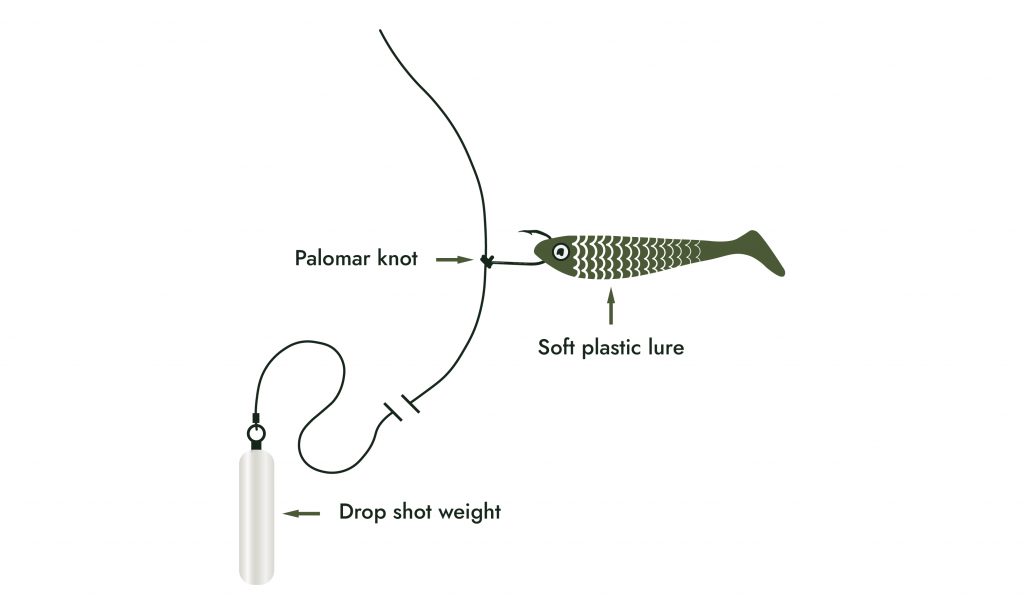
Okay, so what is a drop shot? To describe it in the simplest way possible, it must consist of these three things:
- A line with a hook tied at the end
- A leader trailing from the hook
- Weight at the end of the leader, so it hangs below the hook and bait
Your setup will look exactly like the drawing above. You’ll have your line running down with the hook tied like you normally would, but then you’ll run a leader from that with a small weight on the end.
That’s all there is to it; people like to complicate this fishing strategy thinking that it requires a million different things, but it doesn’t.
Now, when drop shotting for bass, you also need to know about the techniques and fishing methods you can deploy. Rigging your line is half the battle, but the other half is knowing how to fish it.
We’ll get more into that in detail further on down the line, for right now, let’s focus on rigging your drop shot.
How to Rig a Drop Shot? Everything You Need
Let’s talk gear, how much money do you need to go out and spend to fish this technique, luckily you might not need to buy anything because you should have most of the gear already.
Let’s break it down.
Rods and Reels
You’ll catch bass with drop shots; there’s no doubt about it, so you want to make sure you have the right rod and reel when the time comes. I’d suggest going with an extra fast action medium rod with a comfortable spinning reel.
It’s important to remember this is a finesse style of fishing, so you want something that will have the sensitivity to catch small bass but the power you need when you do land a big one.
As for the reel, you don’t need to go too crazy, and whatever you have for freshwater right now will likely work fine.
Line for Drop Shots
When you choose your line to tie a drop shot knot, you’ll want to go with the line that has the lowest visibility, so a six pound test fluorocarbon line and leader should do the trick. Whenever you’re fishing finesse techniques, you want to keep in mind that bass are skittish, and they will nibble and swim away really quickly if you scare them.
Drop Shot Hooks
Hook size for bass is important, and you want to make sure you stay around a 1-1/0. There’s also a lot of different hook styles to choose from, but you want to have a drop shot hook. These have a large hook circumference, and they provide the best action and natural presentation of your bait.
Drop Shot Sinkers
To understand what type of weight you need, you should first understand a bit more about this style of fishing. The purpose of the weight is to keep your bait in place a few inches off the bottom of the water if it’s rough.
So, ideally, you’ll need to use a crimped swivel weight that you can clip onto the end of your line, but you can tie one as well if that’s what you want to do.
I wouldn’t suggest using a weight that is any lighter than ⅜, and I typically use a ¾ oz when there’s a lot of wind outside, and the water is choppy.
It’s recommended that you choose a weight that blends in with your surroundings as well. You don’t want fish nipping and playing with the weight at the bottom, so the more it blends in, the better off you’ll be.
Drop Shot Worms
When fishing a drop shot, you have a few choices for the type of bait you use, but I recommend using plastic worms or something in the same realm. You can use a rubber minnow as well if you prefer, but the presentation of a drop shot works really well if you stick to rubber worms.
One of my personal favorites is anything from the Berkley Gulp! Brand. I think all of their products are awesome, and they usually come scented, which makes it even easier.
Drop shotting takes a lot of the presentation issue out of the equation, so all you need to worry about is choosing a bait that the bass actually wants to eat. As long as you pick something that mimics their natural prey, you’ll be good to go.
Rigging It Up
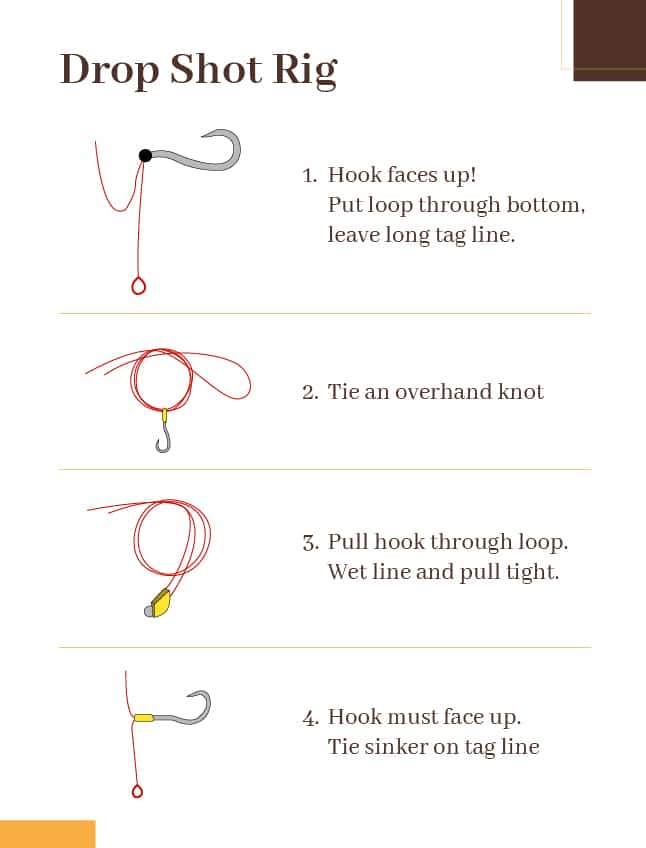
Now you’ve got everything you need, and we can start to talk about how to get this all rigged up. Here are the steps you’ll need to take to rig your first drop shot.
1. Get your hook and run the line through the eye and pull through at least a foot in length for the leader on the tag end.
2. Make a loop and place it back through the bottom of the hook.
3. Hold the loop end and make a single palomar knot with the other end. Wet it and pull it tight.
4. Now you should have a hook tied about a foot up with plenty of line on the other end to tie the weight too.
Once you have it all set up, you can wacky or Texas rig your worm or shad and attach your weight to the end, and you’ve got yourself a drop shot rig.
How to Fish a Drop Shot
YourBassGuy.com writer Wesley Littlefield offers some insights for the drop-shotting in this YouTube video.
Now it’s time to talk about the fun stuff, let’s actually put this rig in the water and see if we can catch anything.
Many people believe that drop shotting for bass means casting out and letting the lure sink to the bottom, and that’s that. There are many strategies and techniques you can use to improve your bass fishing success, so let’s get into some of them.
Deadsticking
One of the most popular techniques for drop shotting is deadsticking. This strategy involves letting the weight fall to the bottom and resting there for around 15 seconds. Then you slowly lift it off the bottom of the water and let it fall back down again for another 15 seconds. You can repeat this process all the way back to the boat, and it’s not common for many minutes to pass between casts.
This method works best when you know where the bass are. You’ll want to have a general idea of where to fish because there isn’t a lot of movement happening. If you know where the bass are and you use this strategy, you’ll have no problem.
Current Fishing
One of the best things about drop shotting is it makes fishing heavy currents very easy. When you’re fishing with a standard weight and lure in heavy currents, it often messes up your presentation, so you need to size up the lures, which doesn’t help either.
For this strategy to work, you need to make sure you have the right size weight. I recommend using a ½ ounce weight because the increase in size will ensure that your lure stays at the bottom of the lake or river.
When fishing this technique, the goal is to let the current do all the work for you. Here you’ll cast out, let the weight sink to the bottom, and if you got it right, you’ll have a beautifully wiggly worm presentation. If the weight is too heavy, it will cause the worm to sink down into the dirt with it. If the weight is too light, your lure and weight will move around, which will mess up your presentation as well.
Fishing Cover
If you’re a bass angler, you know the best place to find them is in shallow, heavily covered areas versus deep water. Hitting these areas with a drop shot is a sure-fire way to catch a lot of bass.
For this technique to work, you need to have a spinning rod and reel because it will help you get the perfect vertical drop. From there, you’ll want to drag the drop shot weight across the bottom until you bump into something. Once that happens, you can shake the line around for a few seconds and see if you get any attention.
If nothing happens, reel it back in and go again. This technique works best in shallow water with dense cover.
Drag It
If you have no idea where the bass are, but you’re determined to catch some with your drop shot, then you’ll want to give this method a try. A lot of experts say that they won’t bite if you jig it around on the bottom, but they bite when you drag it. Maybe it’s because you’re creating a louder disturbance, but who knows.
Anyway, professional anglers use this drop shotting technique, so I would recommend giving it a try. Pitch your bait and let it sink to the bottom. Once it hits bottom, simply retrieve it fast enough to drag the weight across the base of the water.
The Scoop on Drop Shotting
It’s no doubt that drop shotting provides a great strategy for the lake and ponds that are overfished. In my opinion, the best time to test out a drop shot is when you’re not having luck with anything else.
By this point, you should understand just about everything you could want to know about drop shotting for bass. Here are a few key points to remember.
- Choose the right size weight, too heavy or too light will mess up your presentation
- I recommend using Berkley Gulp! Worms rigged waggy style
- Make sure you understand how to rig your hook and weight
- Apply the same basic rules of fishing to this style
That’s about it, good luck, and I hope you have a lot of success catching smallmouth and largemouth with your drop shot fishing!
yourbassguy.comPeople ask me all the time about the drop shot rig and drop shotting for bass.
Many anglers think that drop shotting requires a ton of experience and a finesse angling style that can only be matched by professionals.
All of that couldn’t be any further from the truth. I learned how to drop shot in less than five minutes, that’s before my dad even had a chance to get angry at me.
It’s crucial that you understand that this is both a style of fishing and a method of rigging your bait as well, but essentially, the two work together. There are many different techniques for fishing a drop shot rig and some extra gear you might need to purchase to get everything set up.
No need to worry though, I’m here to help guide you through the process. In this article, you’ll learn how to tie a drop shot, how to fish one, and some expert bass fishing tips and tricks I’ve learned from anglers much much older than me.
Let’s get into it!
Drop Shotting For Bass: What is a Drop Shot?

Okay, so what is a drop shot? To describe it in the simplest way possible, it must consist of these three things:
- A line with a hook tied at the end
- A leader trailing from the hook
- Weight at the end of the leader, so it hangs below the hook and bait
Your setup will look exactly like the drawing above. You’ll have your line running down with the hook tied like you normally would, but then you’ll run a leader from that with a small weight on the end.
That’s all there is to it; people like to complicate this fishing strategy thinking that it requires a million different things, but it doesn’t.
Now, when drop shotting for bass, you also need to know about the techniques and fishing methods you can deploy. Rigging your line is half the battle, but the other half is knowing how to fish it.
We’ll get more into that in detail further on down the line, for right now, let’s focus on rigging your drop shot.
How to Rig a Drop Shot? Everything You Need
Let’s talk gear, how much money do you need to go out and spend to fish this technique, luckily you might not need to buy anything because you should have most of the gear already.
Let’s break it down.
Rods and Reels
You’ll catch bass with drop shots; there’s no doubt about it, so you want to make sure you have the right rod and reel when the time comes. I’d suggest going with an extra fast action medium rod with a comfortable spinning reel.
It’s important to remember this is a finesse style of fishing, so you want something that will have the sensitivity to catch small bass but the power you need when you do land a big one.
As for the reel, you don’t need to go too crazy, and whatever you have for freshwater right now will likely work fine.
Line for Drop Shots
When you choose your line to tie a drop shot knot, you’ll want to go with the line that has the lowest visibility, so a six pound test fluorocarbon line and leader should do the trick. Whenever you’re fishing finesse techniques, you want to keep in mind that bass are skittish, and they will nibble and swim away really quickly if you scare them.
Drop Shot Hooks
Hook size for bass is important, and you want to make sure you stay around a 1-1/0. There’s also a lot of different hook styles to choose from, but you want to have a drop shot hook. These have a large hook circumference, and they provide the best action and natural presentation of your bait.
Drop Shot Sinkers
To understand what type of weight you need, you should first understand a bit more about this style of fishing. The purpose of the weight is to keep your bait in place a few inches off the bottom of the water if it’s rough.
So, ideally, you’ll need to use a crimped swivel weight that you can clip onto the end of your line, but you can tie one as well if that’s what you want to do.
I wouldn’t suggest using a weight that is any lighter than ⅜, and I typically use a ¾ oz when there’s a lot of wind outside, and the water is choppy.
It’s recommended that you choose a weight that blends in with your surroundings as well. You don’t want fish nipping and playing with the weight at the bottom, so the more it blends in, the better off you’ll be.
Drop Shot Worms
When fishing a drop shot, you have a few choices for the type of bait you use, but I recommend using plastic worms or something in the same realm. You can use a rubber minnow as well if you prefer, but the presentation of a drop shot works really well if you stick to rubber worms.
One of my personal favorites is anything from the Berkley Gulp! Brand. I think all of their products are awesome, and they usually come scented, which makes it even easier.
Drop shotting takes a lot of the presentation issue out of the equation, so all you need to worry about is choosing a bait that the bass actually wants to eat. As long as you pick something that mimics their natural prey, you’ll be good to go.
Rigging It Up

Now you’ve got everything you need, and we can start to talk about how to get this all rigged up. Here are the steps you’ll need to take to rig your first drop shot.
1. Get your hook and run the line through the eye and pull through at least a foot in length for the leader on the tag end.
2. Make a loop and place it back through the bottom of the hook.
3. Hold the loop end and make a single palomar knot with the other end. Wet it and pull it tight.
4. Now you should have a hook tied about a foot up with plenty of line on the other end to tie the weight too.
Once you have it all set up, you can wacky or Texas rig your worm or shad and attach your weight to the end, and you’ve got yourself a drop shot rig.
How to Fish a Drop Shot
YourBassGuy.com writer Wesley Littlefield offers some insights for the drop-shotting in this YouTube video.
Now it’s time to talk about the fun stuff, let’s actually put this rig in the water and see if we can catch anything.
Many people believe that drop shotting for bass means casting out and letting the lure sink to the bottom, and that’s that. There are many strategies and techniques you can use to improve your bass fishing success, so let’s get into some of them.
Deadsticking
One of the most popular techniques for drop shotting is deadsticking. This strategy involves letting the weight fall to the bottom and resting there for around 15 seconds. Then you slowly lift it off the bottom of the water and let it fall back down again for another 15 seconds. You can repeat this process all the way back to the boat, and it’s not common for many minutes to pass between casts.
This method works best when you know where the bass are. You’ll want to have a general idea of where to fish because there isn’t a lot of movement happening. If you know where the bass are and you use this strategy, you’ll have no problem.
Current Fishing
One of the best things about drop shotting is it makes fishing heavy currents very easy. When you’re fishing with a standard weight and lure in heavy currents, it often messes up your presentation, so you need to size up the lures, which doesn’t help either.
For this strategy to work, you need to make sure you have the right size weight. I recommend using a ½ ounce weight because the increase in size will ensure that your lure stays at the bottom of the lake or river.
When fishing this technique, the goal is to let the current do all the work for you. Here you’ll cast out, let the weight sink to the bottom, and if you got it right, you’ll have a beautifully wiggly worm presentation. If the weight is too heavy, it will cause the worm to sink down into the dirt with it. If the weight is too light, your lure and weight will move around, which will mess up your presentation as well.
Fishing Cover
If you’re a bass angler, you know the best place to find them is in shallow, heavily covered areas versus deep water. Hitting these areas with a drop shot is a sure-fire way to catch a lot of bass.
For this technique to work, you need to have a spinning rod and reel because it will help you get the perfect vertical drop. From there, you’ll want to drag the drop shot weight across the bottom until you bump into something. Once that happens, you can shake the line around for a few seconds and see if you get any attention.
If nothing happens, reel it back in and go again. This technique works best in shallow water with dense cover.
Drag It
If you have no idea where the bass are, but you’re determined to catch some with your drop shot, then you’ll want to give this method a try. A lot of experts say that they won’t bite if you jig it around on the bottom, but they bite when you drag it. Maybe it’s because you’re creating a louder disturbance, but who knows.
Anyway, professional anglers use this drop shotting technique, so I would recommend giving it a try. Pitch your bait and let it sink to the bottom. Once it hits bottom, simply retrieve it fast enough to drag the weight across the base of the water.
The Scoop on Drop Shotting
It’s no doubt that drop shotting provides a great strategy for the lake and ponds that are overfished. In my opinion, the best time to test out a drop shot is when you’re not having luck with anything else.
By this point, you should understand just about everything you could want to know about drop shotting for bass. Here are a few key points to remember.
- Choose the right size weight, too heavy or too light will mess up your presentation
- I recommend using Berkley Gulp! Worms rigged waggy style
- Make sure you understand how to rig your hook and weight
- Apply the same basic rules of fishing to this style
That’s about it, good luck, and I hope you have a lot of success catching smallmouth and largemouth with your drop shot fishing!

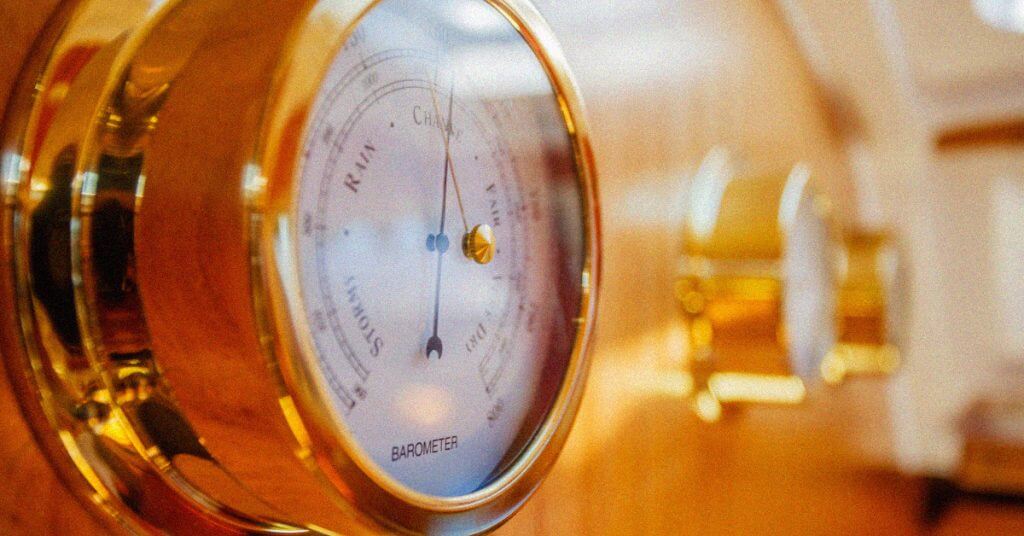
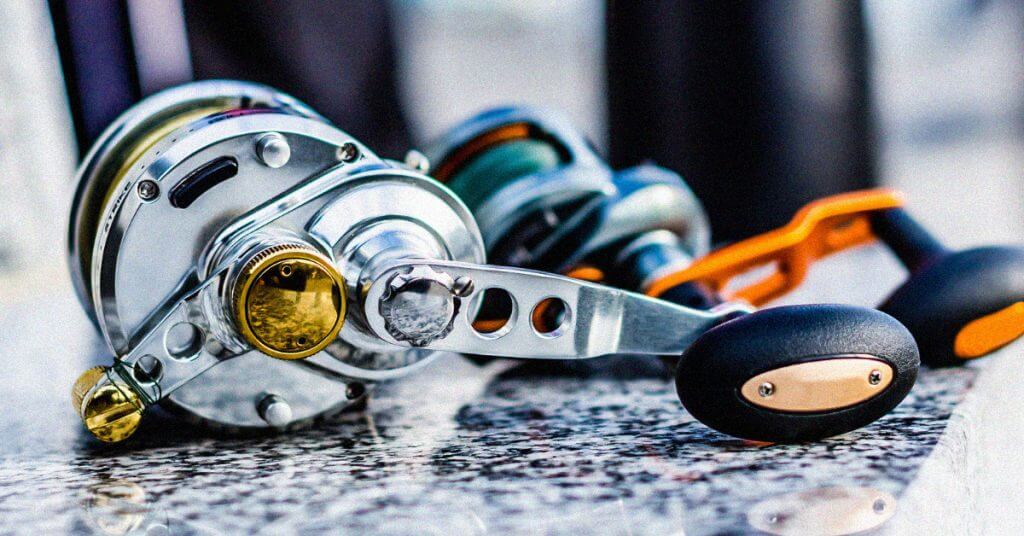
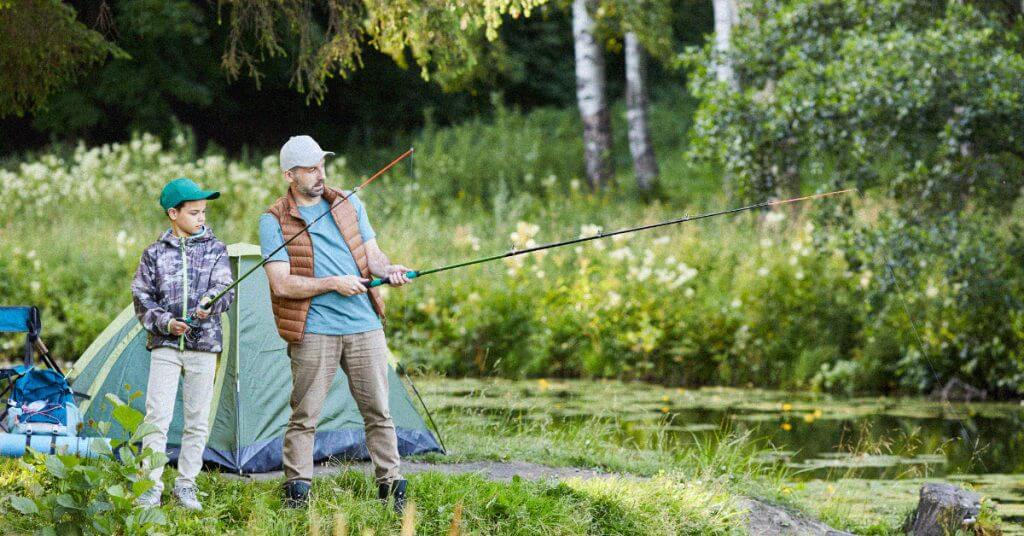

Thanks for the info
That’s what we’re here for 🙂
Glad we could help, Shane!
Can a Drop Shot be rigged under a Slip Bobber Rig with success?